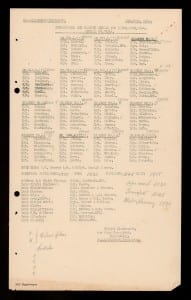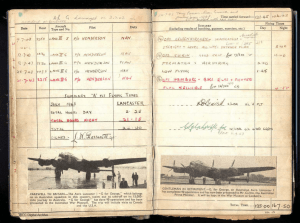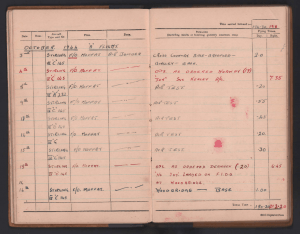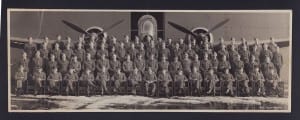Handwritten transcriptions
The IBCC Digital Archive is unusual in that its collections are described at item level and sometimes page level, and many are fully transcribed.
It is our aim to transcribe all our oral history interviews and written documents, and so far around one third of the items published in by the IBCC Digital Archive that contain text or spoken word include transcriptions.
This enables users of the archive to use ‘keyword’ or ‘exact match’ searches to find people, places, events, and all manner of things of historical interest far beyond what the cataloguer may have deemed worthy of including in a brief abstract or description of a document.
For example, where names have been written on the reverse of a photograph these will be discoverable through a transcription.
Each of the 81 aircrew in the photograph will now appear in searches of the IBCC Digital Archive.
Letters and telegrams have also been transcribed.
Sergeant Spencer Lewis Belton flew as an observer/ bomb aimer with 144 Squadron from RAF Hemswell. He was awarded the Distinguished Flying Medal after an operation to Wilhelmshaven in July 1940. In this letter to his father, he discusses his radio interview with the BBC about his award.
Memoirs have been transcribed.

Betty Bascombe’s memoir includes information about her first husband, Ron Jones, who was killed in action 25 April 1944. Betty met her second husband, Bert Bascombe, when she was serving with the Auxiliary Territorial Service in Hamburg.
Betty Bascombe’s memoir includes information about her first husband, Ron Jones, who was killed in action 25 April 1944. Betty met her second husband, Bert Bascombe, when she was serving with the Auxiliary Territorial Service in Hamburg.
Some service documents have been transcribed.

This page from 44 Squadron’s Operations Order Book lists the duty personnel and crews and aircraft for operations and training for 2/3 June 1944.
As well as military and aviation historians, these transcriptions should make the IBCC Digital Archive of interest for people researching family history, and for social and cultural historians.
This level of detail would not be possible without our teams of dedicated volunteers. All have attended training sessions as it is important that different documents transcribed by different people are transcribed consistently. Training covers how to deal with spelling mistakes, insertions, underlining’s and the like. Some historical knowledge is required to recognise cultural references to people, equipment and events, and faded handwritten documents in 1940s cursive script can be hard to read until you learn to recognise the writer’s individual style. Transcribers can spend a long time trying to decipher a particular word, and they are among the first people to read these documents since the 1940s. Thanks should go to all our transcribers, but particularly to Tricia Marshall who recently transcribed 110 items in one month, and to Anne-Marie Watson who transcribed over 10,000 words over a single weekend.
Log books
Log books record aircrew flying hours, and during the war the RAF produced different types of log books for pilots, for navigators, air bombers and air gunners, and for observers and air gunners. They contain a record of every flight a single person undertook including training and operational flights. Day time flights were usually written in green ink and night time flights in red. Many aircrew numbered their operational flights to keep count of their tour of 30 operations. Although they were an official document, they are frequently annotated with comments such as ‘good prang’ or ‘attacked by night fighter’, and some also now contain photographs and newspaper cuttings.

A page from Leonard Dorricott’s Royal Canadian Air Force observer’s and air gunner’s flying log book from 27 November 1942 to 21 January 1946. It details his training schedule, instructional duties and operations flown. Len Dorricott trained as a navigator in Miami, Florida and completed 32 operations on tours with 460 and 576 Squadrons.
Log books are valuable historical sources and sometime change hands for large sums. However, the content of log books in the IBCC Digital Archive is searchable and available to download for free under a CC BY-NC 4.0 International license (Creative Commons Attribution-NonCommercial 4.0).
The IBCC Digital Archive has already published over 30 log books, including a South African Air Force log book and several Royal Canadian Air Force books.
We have taken a slightly different approach to how log books have been included in the archive. Rather than transcribing the whole document, which would be very time consuming, they have been ‘data-mined’ for their content. Log books in the archive can be searched for aircraft flown, stations served at, squadrons, targets and operations using tags, keywords, and geolocation.

A page from Peter Bellingham’s log book. His log book covers his training and operational career as a of bomb aimer from 10 March 1943 to 21 February 1946. After training in South Africa he flew in Halifaxes and Stirlings with 138 Squadron, taking part in 30 night operations over Denmark, France, Germany, and Norway before becoming an instructor. As he flew operations with the Special Operations Executive, dropping supplies and agents into occupied Europe, his targets are unspecified. The outcomes are recorded as either as ‘Joy’ or ‘No joy’.
Unlike the majority of scans of historical documents available on the Internet, ours are published with an uninterrupted margin. This margin acts as an integrity check; users can verify for themselves that the scan has not been cropped, even if the original is no longer available for comparison.
Dan Ellin, Archive curator



![E[Author]BeltonSLS400731-010001](https://ibccdigitalarchive.blogs.lincoln.ac.uk/files/2018/09/EAuthorBeltonSLS400731-010001-300x250.jpg)
![E[Author]BeltonSLS400731-010002](https://ibccdigitalarchive.blogs.lincoln.ac.uk/files/2018/09/EAuthorBeltonSLS400731-010002-199x300.jpg)
![E[Author]BeltonSLS400731-010003](https://ibccdigitalarchive.blogs.lincoln.ac.uk/files/2018/09/EAuthorBeltonSLS400731-010003-201x300.jpg)